EO-1 Data Quality and Sensor Stability with Changing Orbital Precession at the End of a 16 Year Mission
Abstract
:1. Introduction
Orbital Precession Rate Change
- Larger SZAs due to the sun being closer to the horizon may reduce the quality of the signal by having weaker irradiances and a longer atmospheric path for radiances to traverse, which decreases the signal to noise (SNR) ratio of the data and complicates atmospheric correction procedures;
- There is a change in the number of instances of cloudy data, which might increase in temperate zones, as early morning haze is more often present, and might decrease in tropical zones, where convective clouds dominate [22];
- The bi-directional reflectance distribution function (BRDF) of the data changes as the influence of shadows increases in concert with the illumination angles, and somewhat larger footprints are viewed [23].
2. Data and Methods
2.1. EO-1 Instrument Characteristics
2.2. Study Methods
- (1)
- (2)
- Howland Forest, Maine: The NDVI obtained from Hyperion surface reflectance was compared to the NDVI obtained with the Moderate Resolution Imaging Spectroradiometer (MODIS) for an experimental mixed forest, in multiple years;
- (3)
- US Department of Agriculture/Beltsville Agriculture Research Center (USDA/BARC) in Beltsville, Maryland: The temporal change in the Hyperion surface reflectance was evaluated using 1st derivative analysis, in an agriculture site over multiple years;
- (4)
- Rail Road Valley Playa (RRVP), Nevada: For a Pseudo-Invariant Calibration Site (PICS), a Hyperion surface reflectance time-series was evaluated for a bright desert target site; and
- (5)
- The Libya-4 PICS, Libya: Statistical evaluation of the change in surface reflectance obtained in different spectral intervals and over time was evaluated using a dense Hyperion surface reflectance time-series for a bright desert target site.
2.2.1. Park Falls Wisconsin—EO-1/ALI NDVI vs. Landsat NDVI
2.2.2. Howland Forest, Maine—Hyperion NDVI Comparison to MODIS NDVI
2.2.3. BARC—Surface Reflectance at USDA Site with Derivative Analysis
2.2.4. Rail Road Valley Playa (RRVP) PICS—Surface Reflectance at a Desert Site
2.2.5. Libya-4 PICS—Hyperion Time-Series Using Different Atmospheric Correction Models
3. Results
3.1. Park Falls, Wisconsin: EO-1 ALI NDVI vs. Landsat NDVI
3.2. Howland Forest, Maine—Hyperion NDVI Comparison to MODIS NDVI
3.3. BARC—Hyperion Surface Reflectance Derivative Analysis
3.4. RRVP—Desert Site Surface Reflectance Time Series
3.5. Libya-4 PICS—Hyperion Surface Reflectance Stability Using Three Atmopheric Correction Models
4. Discussion
5. Conclusions
Acknowledgments
Author Contributions
Conflicts of Interest
Abbreviations
| ACORN | Atmospheric CORrection Now |
| ALI | Advanced Land Imager |
| ATREM | Atmosphere Removal |
| BARC | Beltsville Agricultural Research Center |
| BRDF | Bi-Directional Reflectance Distribution Function |
| CEOS | Committee on Earth Observing Satellites |
| CV | Coefficient of Variation |
| EO-1 | Earth Observing One |
| ETM+ | Enhanced Thematic Mapper plus |
| FLAASH | Fast Line-of-sight Atmospheric Analysis of Spectral Hypercubes |
| TM | Thematic Mapper |
| MODIS | Moderate Resolution Imaging Spectroradiometer |
| NDVI | Normalized Difference Vegetation Index |
| NIR | Near Infrared |
| PICS | Pseudo-Invariant Calibration Site |
| RRVP | Rail Road Valley Playa |
| SNR | Signal to Noise Ratio |
| SWIR | Short Wave Infrared |
| SZA | Solar Zenith Angle |
| TOA | Top of Atmosphere |
| USGS | United States Geological Survey |
| VNIR | Visible Near Infrared |
| WRS | Worldwide Reference System |
References
- Elmore, A.J.; Mustard, J.F. Precision and Accuracy of EO-1 Advanced Land Imager (ALI) Data for Semiarid Vegetation Studies. IEEE Trans. Geosci. Remote Sens. 2003, 41, 1311–1320. [Google Scholar] [CrossRef]
- Datt, B.; McVicar, T.R.; Van Niel, T.G.; Jupp, D.L.B.; Pearlman, J.S. Preprocessing EO-1 Hyperion Hyperspectral Data to Support the Application of Agricultural Indexes. IEEE Trans. Geosci. Remote Sens. 2003, 41, 1246–1259. [Google Scholar] [CrossRef]
- Ungar, S.G.; Pearlman, J.S.; Mendenhall, J.A.; Reuter, D. Overview of the Earth Observing One (EO-1) Mission. IEEE Trans. Geosci. Remote Sens. 2003, 41, 1149–1159. [Google Scholar] [CrossRef]
- Bryant, R.; Moran, M.S.; McElroy, S.A.; Holifield, C.; Thome, K.J.; Miura, T.; Biggar, S.F. Data Continuity of Earth Observing 1 (EO-1) Advanced Land Imager (ALI) and Landsat Tm and ETM. IEEE Trans. Geosci. Remote Sens. 2003, 41, 1204–1214. [Google Scholar] [CrossRef]
- Pu, R.; Yu, Q.; Gong, P.; Biging, G.S. EO-1 Hyperion, ALI and Landsat 7 ETM+ Data Comparison for Estimating Forest Crown Closure and Leaf Area Index. Int. J. Remote Sens. 2005, 26, 457–474. [Google Scholar] [CrossRef]
- Roy, D.P.; Wulder, M.A.; Loveland, T.R.; Woodcock, C.E.; Allen, R.G.; Anderson, M.C.; Helder, D.; Irons, J.R.; Johnson, D.M.; Kennedy, R.; et al. Landsat-8: Science and Product Vision for Terrestrial Global Change Research. Remote Sens. Environ. 2014, 145, 154–172. [Google Scholar] [CrossRef]
- Irons, J.R.; Dwyer, J.L.; Barsi, J.A. The Next Landsat Satellite: The Landsat Data Continuity Mission. Remote Sens. Environ. 2012, 122, 11–21. [Google Scholar] [CrossRef]
- Ungar, S.; NASA, Greenbelt, NE, USA. Personal communication, 2016.
- Middleton, E.M.; Ungar, S.G.; Mandl, D.J.; Ong, L.; Frye, S.W.; Campbell, P.E.; Landis, D.R.; Young, J.P.; Pollack, N.H. The Earth Observing One (EO-1) Satellite Mission: Over a Decade in Space. IEEE J. Sel. Top. Appl. Earth Obs. Remote Sens. 2013, 6, 243–256. [Google Scholar] [CrossRef]
- Fagan, M.E.; DeFries, R.S.; Sesnie, S.E.; Arroyo-Mora, J.P.; Soto, C.; Singh, A.; Townsend, P.A.; Chazdon, R.L. Mapping Species Composition of Forests and Tree Plantations in Northeastern Costa Rica with an Integration of Hyperspectral and Multitemporal Landsat Imagery. Remote Sens. 2015, 7, 5660–5696. [Google Scholar] [CrossRef]
- White, J.C.; Gomez, C.; Wulder, M.A.; Coops, N.C. Characterizing Temperate Forest Structural and Spectral Diversity with Hyperion EO-1 Data. Remote Sens. Environ. 2010, 114, 1576–1589. [Google Scholar] [CrossRef]
- Blanco, P.D.; del Valle, H.F.; Bouza, P.J.; Metternicht, G.I.; Hardtke, L.A. Ecological Site Classification of Semiarid Rangelands: Synergistic Use of Landsat and Hyperion Imagery. Int. J. Appl. Earth Obs. Geoinform. 2014, 29, 11–21. [Google Scholar] [CrossRef]
- Chen, S.; Fang, L.; Li, H.; Chen, W.; Huang, W. Evaluation of a Three-Band Model for Estimating Chlorophyll-a Concentration in Tidal Reaches of the Pearl River Estuary, China. ISPRS-J. Photogramm. Remote Sens. 2011, 66, 356–364. [Google Scholar] [CrossRef]
- Brando, V.E.; Dekker, A.G. Satellite Hyperspectral Remote Sensing for Estimating Estuarine and Coastal Water Quality. IEEE Trans. Geosci. Remote Sens. 2003, 41, 1378–1387. [Google Scholar] [CrossRef]
- Chudnovsky, A.; Kostinski, A.; Herrmann, L.; Koren, I.; Nutesku, G.; Ben-Dor, E. Hyperspectral Spaceborne Imaging of Dust-Laden Flows: Anatomy of Saharan Dust Storm from the Bodele Depression. Remote Sens. Environ. 2011, 115, 1013–1024. [Google Scholar] [CrossRef]
- Chien, S.; Doubleday, J.; Mclaren, D.; Tran, D.; Tanpipat, V.; Chitradon, R.; Boonya-aroonnet, S.; Thanapakpawin, P.; Mandl, D. Monitoring Flooding in Thailand Using Earth Observing One in a Sensorweb. IEEE J. Sel. Top. Appl. Earth Obs. Remote Sens. 2013, 6, 291–297. [Google Scholar] [CrossRef]
- Davies, A.G.; Chien, S.; Doubleday, J.; Tran, D.; Thordarson, T.; Gudmundsson, M.T.; Hoskuldsson, A.; Jakobsdottir, S.S.; Wright, R.; Mandl, D. Observing Iceland’s Eyjafjallajokull 2010 Eruptions with the Autonomous Nasa Volcano Sensor Web. J. Geophys. Res. Solid Earth 2013, 118, 1936–1956. [Google Scholar] [CrossRef]
- Mandl, D.; Frye, S.; Cappelaere, P.; Handy, M.; Policelli, F.; Katjizeu, M.; Van Langenhove, G.; Aube, G.; Saulnier, J.F.; Sohlberg, R.; et al. Use of the Earth Observing One (EO-1) Satellite for the Namibia Sensorweb Flood Early Warning Pilot. IEEE J. Sel. Top. Appl. Earth Obs. Remote Sens. 2013, 6, 298–308. [Google Scholar] [CrossRef]
- Davies, A.G.; Chien, S.; Baker, V.; Doggett, T.; Dohm, J.; Greeley, R.; Ip, F.; Castano, R.; Cichy, B.; Rabideau, G.; et al. Monitoring Active Volcanism with the Autonomous Sciencecraft Experiment on EO-1. Remote Sens. Environ. 2006, 101, 427–446. [Google Scholar] [CrossRef]
- Ramsey, M.S.; Flynn, L.P. Strategies, Insights, and the Recent Advances in Volcanic Monitoring and Mapping with Data from Nasxs Earth Observing System. J. Volcanol. Geotherm. Res. 2004, 135, 1–11. [Google Scholar] [CrossRef]
- Swinnen, E.; Verbeiren, S.; Deronde, B.; Henry, P. Assessment of the Impact of the Orbital Drift of SPOT-VGT1 by Comparison with SPOT-VGT2 Data. Int. J. Remote Sens. 2014, 35, 2421–2439. [Google Scholar] [CrossRef]
- Devasthale, A.; Grassl, H. Dependence of Frequency of Convective Cloud Occurrence on the Orbital Drift of Satellites. Int. J. Remote Sens. 2007, 28, 3701–3706. [Google Scholar] [CrossRef]
- Negri, A.J.; Bell, T.L.; Xu, L.M. Sampling of the Diurnal Cycle of Precipitation Using Trmm. J. Atmos. Ocean. Technol. 2002, 19, 1333–1344. [Google Scholar] [CrossRef]
- United States Geological Survey (USGS), Earth Resources Observation and Science (EROS) Center. Available online: https://earthexplorer.usgs.gov/ (accessed on 24 August 2016).
- Rouse, J.W.; Haas, R.H.; Schell, J.A.; Deering, D.W. Monitoring Vegetation Systems in the Great Plains with Erts; NASA: Washington, WA, USA, 1974.
- Tucker, C.J. Red and Photographic Infrared Linear Combinations for Monitoring Vegetation. Remote Sens. Environ. 1979, 8, 127–150. [Google Scholar] [CrossRef]
- Galvao, L.S.; Ponzoni, F.J.; Epiphanio, J.C.N.; Rudorff, B.F.T.; Formaggio, A.R. Sun and View Angle Effects on NDVI Determination of Land Cover Types in the Brazilian Amazon Region with Hyperspectral Data. Int. J. Remote Sens. 2004, 25, 1861–1879. [Google Scholar] [CrossRef]
- Homer, C.; Dewitz, J.; Yang, L.M.; Jin, S.; Danielson, P.; Xian, G.; Coulston, J.; Herold, N.; Wickham, J.; Megown, K. Completion of the 2011 National Land Cover Database for the Conterminous United States—Representing a Decade of Land Cover Change Information. Photogramm. Eng. Remote Sens. 2015, 81, 345–354. [Google Scholar]
- Gao, B.C.; Davis, C.O. Development of a Line-by-Line-Based Atmosphere Removal Algorithm for Airborne and Spaceborne Imaging Spectrometers. In Proceedings of the SPIE 3118, Imaging Spectrometry III, San Diego, CA, USA, 27 July 1997; pp. 132–141. [Google Scholar]
- Gao, B.C.; Heidebrecht, K.B.; Goetz, A.F.H. Derivation of Scaled Surface Reflectances from AVIRIS Data. Remote Sens. Environ. 1993, 44, 165–178. [Google Scholar] [CrossRef]
- National Aeronautics and Space Administration (NASA). Level-1 and Atmosphere Archive & Distribution System (LAADS). Available online: https://ladsweb.nascom.nasa.gov/ (accessed on 30 December 2016).
- Zhang, Q.Y.; Cheng, Y.B.; Lyapustin, A.I.; Wang, Y.J.; Gao, F.; Suyker, A.; Verma, S.; Middleton, E.M. Estimation of Crop Gross Primary Production (GPP): fAPAR(Chl) Versus MOD15A2 FPAR. Remote Sens. Environ. 2014, 153, 1–6. [Google Scholar] [CrossRef]
- Lyapustin, A.I.; Wang, Y.J.; Laszlo, I.; Hilker, T.; Hall, F.G.; Sellers, P.J.; Tucker, C.J.; Korkin, S.V. Multi-Angle Implementation of Atmospheric Correction for MODIS (MAIAC): 3. Atmospheric Correction. Remote Sens. Environ. 2012, 127, 385–393. [Google Scholar] [CrossRef]
- Felde, G.W.; Anderson, G.P.; Cooley, T.W.; Mathew, M.W.; Adler-Golden, S.M.; Berk, A.; Lee, J. Analysis of Hyperion Data with the FLAASH Atmospheric Correction Algorithm. In Proceedings of the Geoscience and Remote Sensing Symposium, Toulouse, France, 21–25 July 2003; pp. 90–92. [Google Scholar]
- Tsai, F.; Philpot, W. Derivative Analysis of Hyperspectral Data. Remote Sens. Environ. 1998, 66, 41–51. [Google Scholar] [CrossRef]
- Kalluri, H.R.; Prasad, S.; Bruce, L.M. Decision-Level Fusion of Spectral Reflectance and Derivative Information for Robust Hyperspectral Land Cover Classification. IEEE Trans. Geosci. Remote Sens. 2010, 48, 4047–4058. [Google Scholar] [CrossRef]
- Ye, Z.; He, M.Y.; Fowler, J.E.; Du, Q. Hyperspectral Image Classification Based on Spectra Derivative Features and Locality Preserving Analysis. In Proceedings of the 2014 IEEE China Summit & International Conference on Signal and Information Processing, Xi’an, China, 9–13 July 2014; pp. 138–142. [Google Scholar]
- Cleveland, W.S. Robust Locally Weighted Regression and Smoothing Scatterplots. J. Am. Stat. Assoc. 1979, 74, 829–836. [Google Scholar] [CrossRef]
- Harris Geospatial Solutions, ENVI Region of Interest (ROI) Tool. Available online: https://www.harrisgeospatial.com/docs/RegionOfInterestTool.html (accessed on 21 April 2017).
- Teillet, P.M.; Barsi, J.A.; Chander, G.; Thome, K.J.; Xiong, J. Prime Candidate Earth Targets for the Post-Launch Radiometric Calibration of Space-Based Optical Imaging Instruments. Proc. SPIE 2007, 6677. [Google Scholar] [CrossRef]
- Scott, K.P.; Thome, K.J.; Brownlee, M.R. Evaluation of the Railroad Valley Playa for Use in Vicarious Calibration. Proc. SPIE 1996, 2818, 158–166. [Google Scholar]
- Teillet, P.M.; Ren, X.M. Spectral Band Difference Effects on Vegetation Indices Derived from Multiple Satellite Sensor Data. Can. J. Remote Sens. 2008, 34, 159–173. [Google Scholar]
- Czapla-Myers, J.S.; Thome, K.J.; Biggar, S.F. Design, Calibration, and Characterization of a Field Radiometer Using Light-Emitting Diodes as Detectors. Appl. Opt. 2008, 47, 6753–6762. [Google Scholar] [CrossRef] [PubMed]
- Czapla-Myers, J.; Ong, L.; Thome, K.; McCorkel, J. Validation of EO-1 Hyperion and Advanced Land Imager Using the Radiometric Calibration Test Site at Railroad Valley, Nevada. IEEE J. Sel. Top. Appl. Earth Obs. Remote Sens. 2016, 9, 816–826. [Google Scholar] [CrossRef]
- Campbell, P.K.E.; Middleton, E.M.; Thome, K.J.; Kokaly, R.F.; Huemmrich, K.F.; Lagomasino, D.; Novick, K.A.; Brunsell, N.A. EO-1 Hyperion Reflectance Time Series at Calibration and Validation Sites: Stability and Sensitivity to Seasonal Dynamics. IEEE J. Sel. Top. Appl. Earth Obs. Remote Sens. 2013, 6, 276–290. [Google Scholar] [CrossRef]
- Analytical Imaging and Geophysics (AIG). ACORN User’s Guide; Stand Alone Version; Analytical Imaging and Geophysics LLC: Boulder, CO, USA, 2001. [Google Scholar]
- Kruse, F.A.; Boardman, J.W.; Huntington, J.F. Comparison of Airborne Hyperspectral Data and EO-1 Hyperion for Mineral Mapping. IEEE Trans. Geosci. Remote Sens. 2003, 41, 1388–1400. [Google Scholar] [CrossRef]
- Gao, B.C.; Goetz, A.F.H. Column Atmospheric Water Vapor and Vegetation Liquid Water Retrievals from Airborne Imaging Spectrometer Data. J. Geophys. Res. 1990, 95, 3549–3564. [Google Scholar] [CrossRef]
- Kruse, F.A. Comparison of ATREM, ACORN, and FLAASH Atmospheric Corrections Using Low-Altitude AVIRIS Data of Boulder, Colorado. In Proceedings of the 13th JPL Airborne Geoscience Workshop, Pasadena, CA, USA, 31 March–2 April 2004; pp. 1–10. [Google Scholar]
- Taylor, J.R. An Introduction to Error Analysis the Study of Uncertainties in Physical Measurements; University Science Books: Sausalito, CA, USA, 1939; p. 327. [Google Scholar]
- Neigh, C.S.R.; McCorkel, J.; Campbell, P.; Ong, L.; Ly, V.; Landis, D.; Fry, S.; Middleton, E.M. Monitoring Orbital Precession of EO-1 Hyperion with Three Atmospheric Correction Models in the Libya-4 Pics. IEEE Geosci. Remote Sen. Lett. 2016, 12, 1797–1801. [Google Scholar] [CrossRef]
- Thompson, D.R.; Thorpe, A.K.; Frankenberg, C.; Green, R.O.; Duren, R.; Guanter, L.; Hollstein, A.; Middleton, E.; Ong, L.; Ungar, S. Space-Based Remote Imaging Spectroscopy of the Aliso Canyon CH4 Superemitter. Geophys. Res. Lett. 2016, 43, 6571–6578. [Google Scholar] [CrossRef]
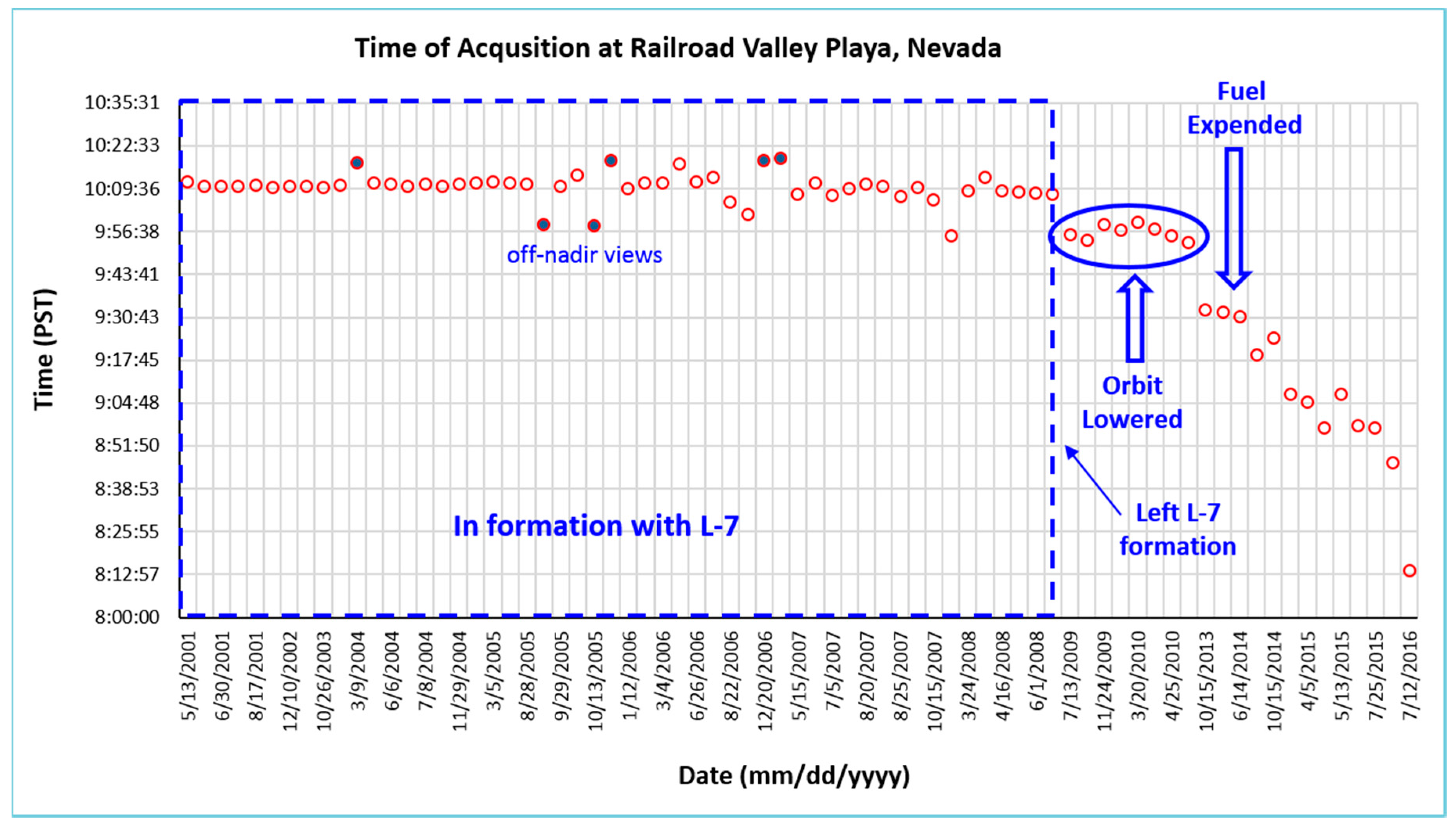

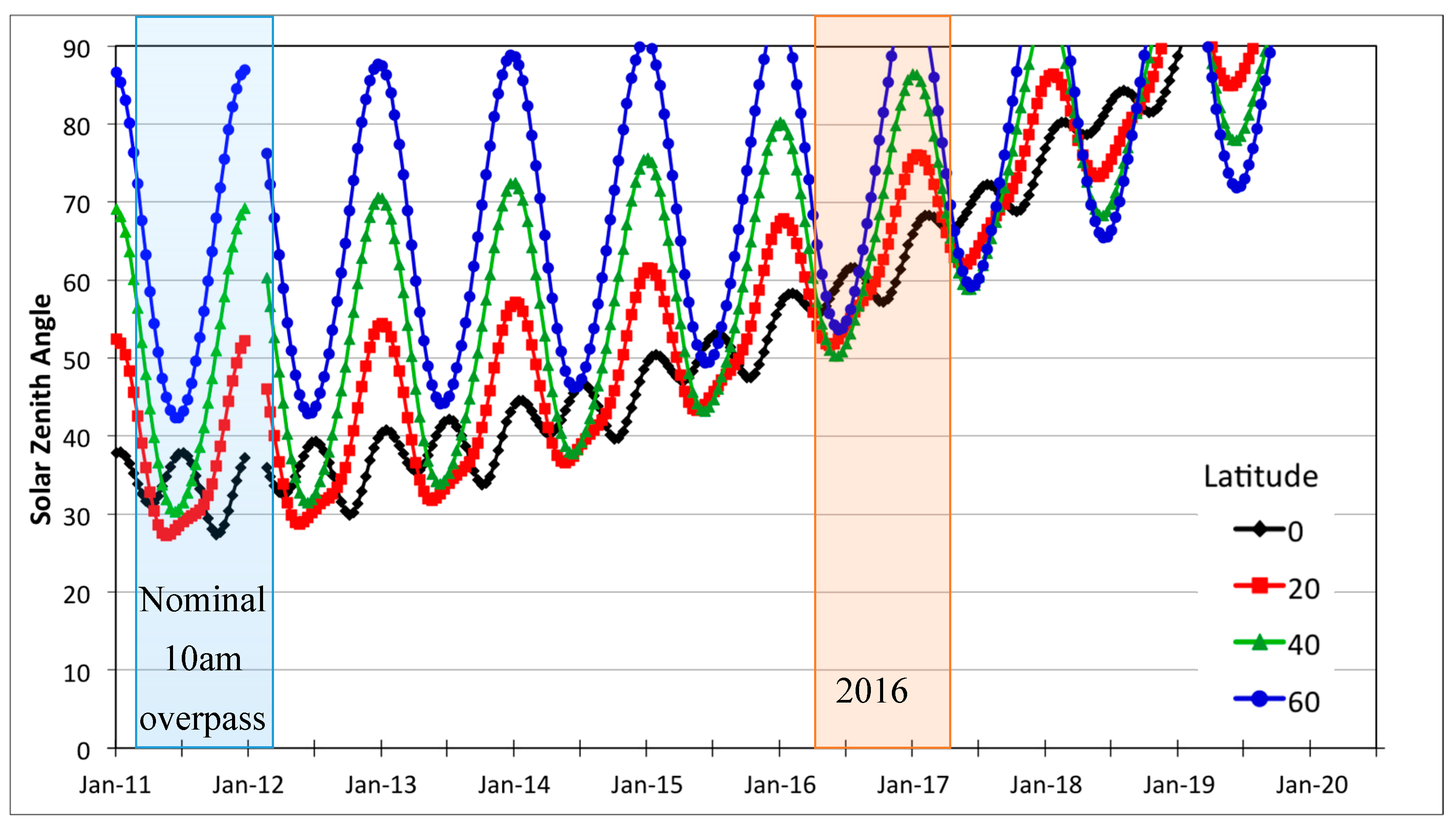
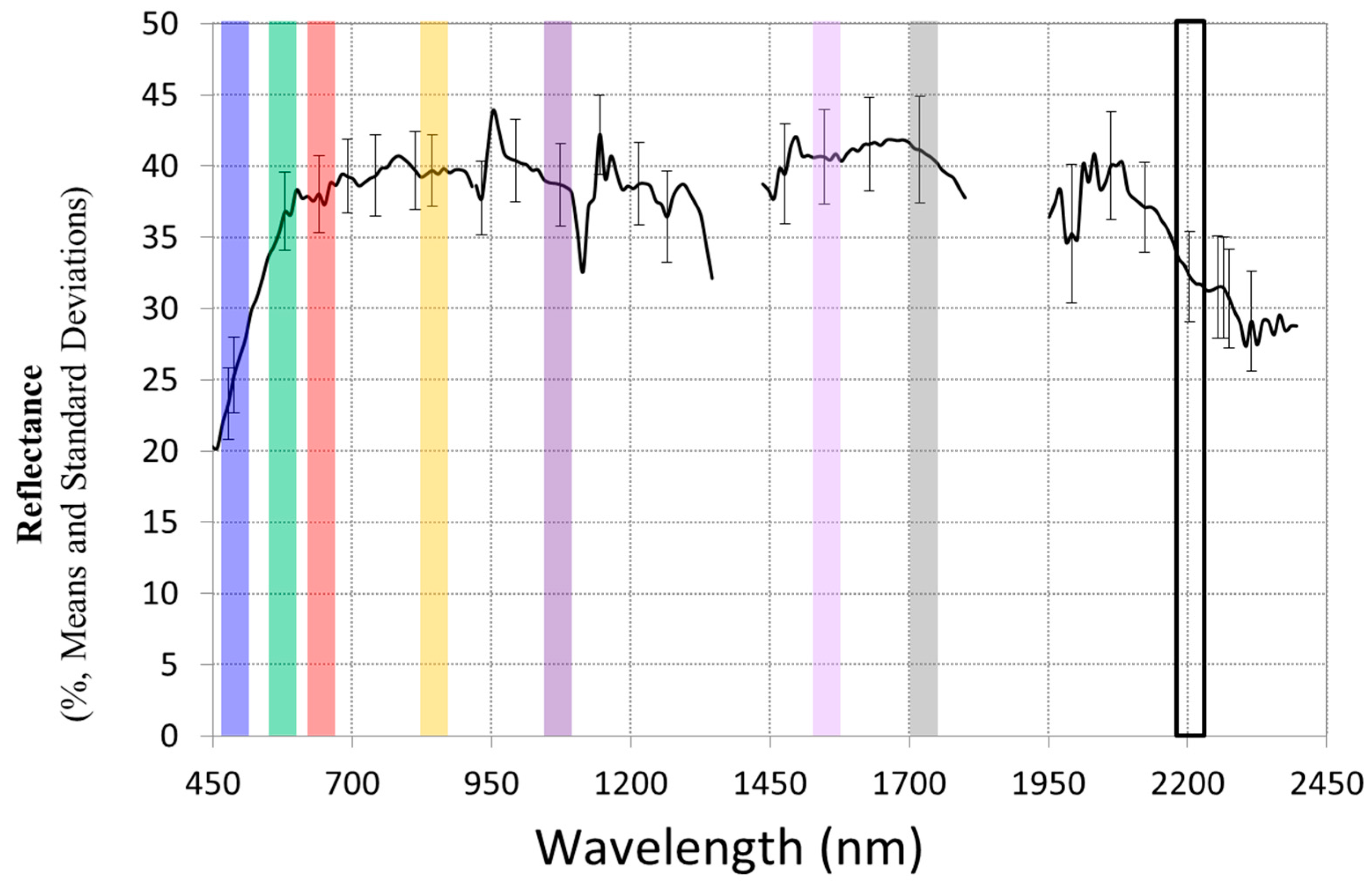

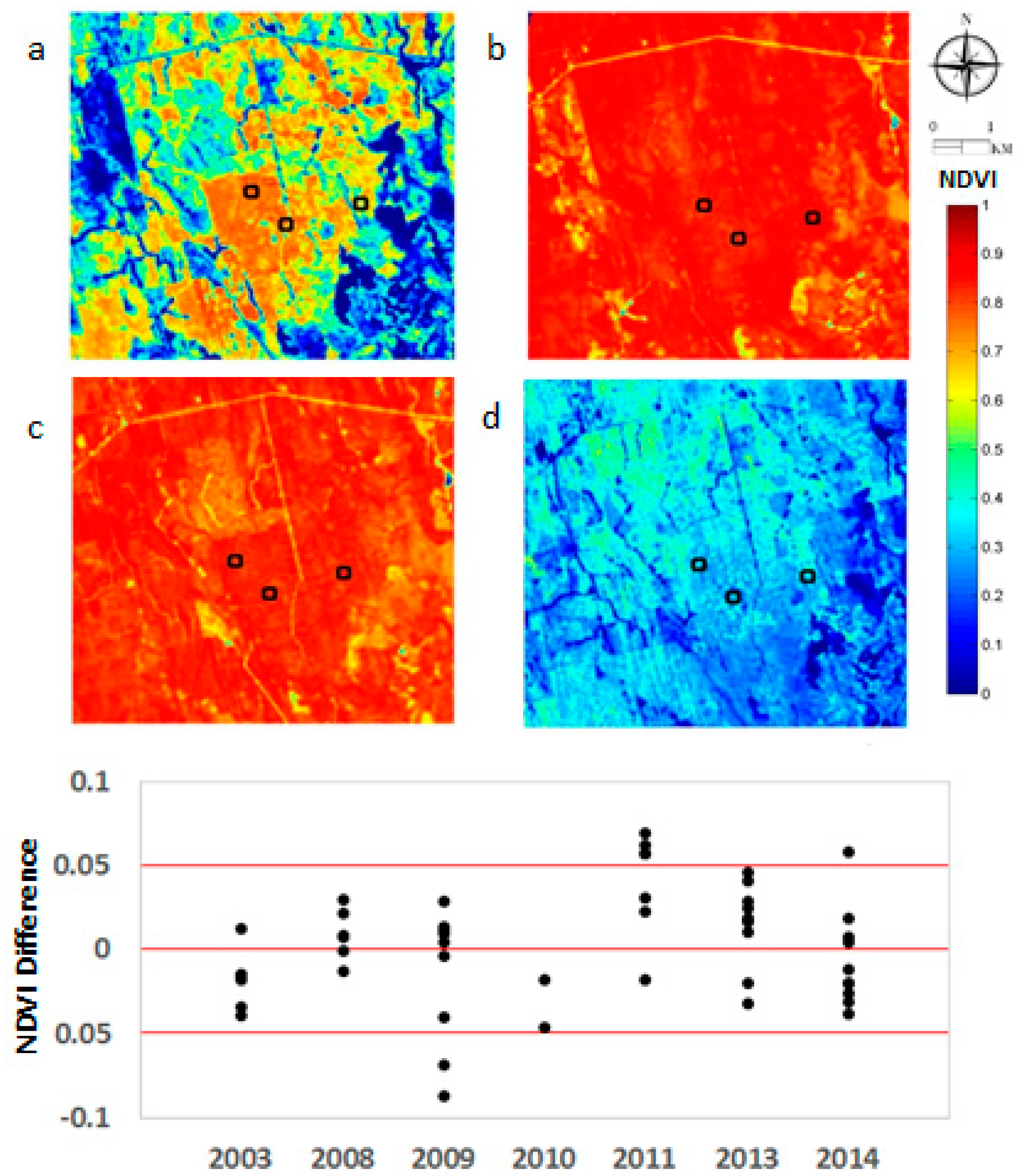
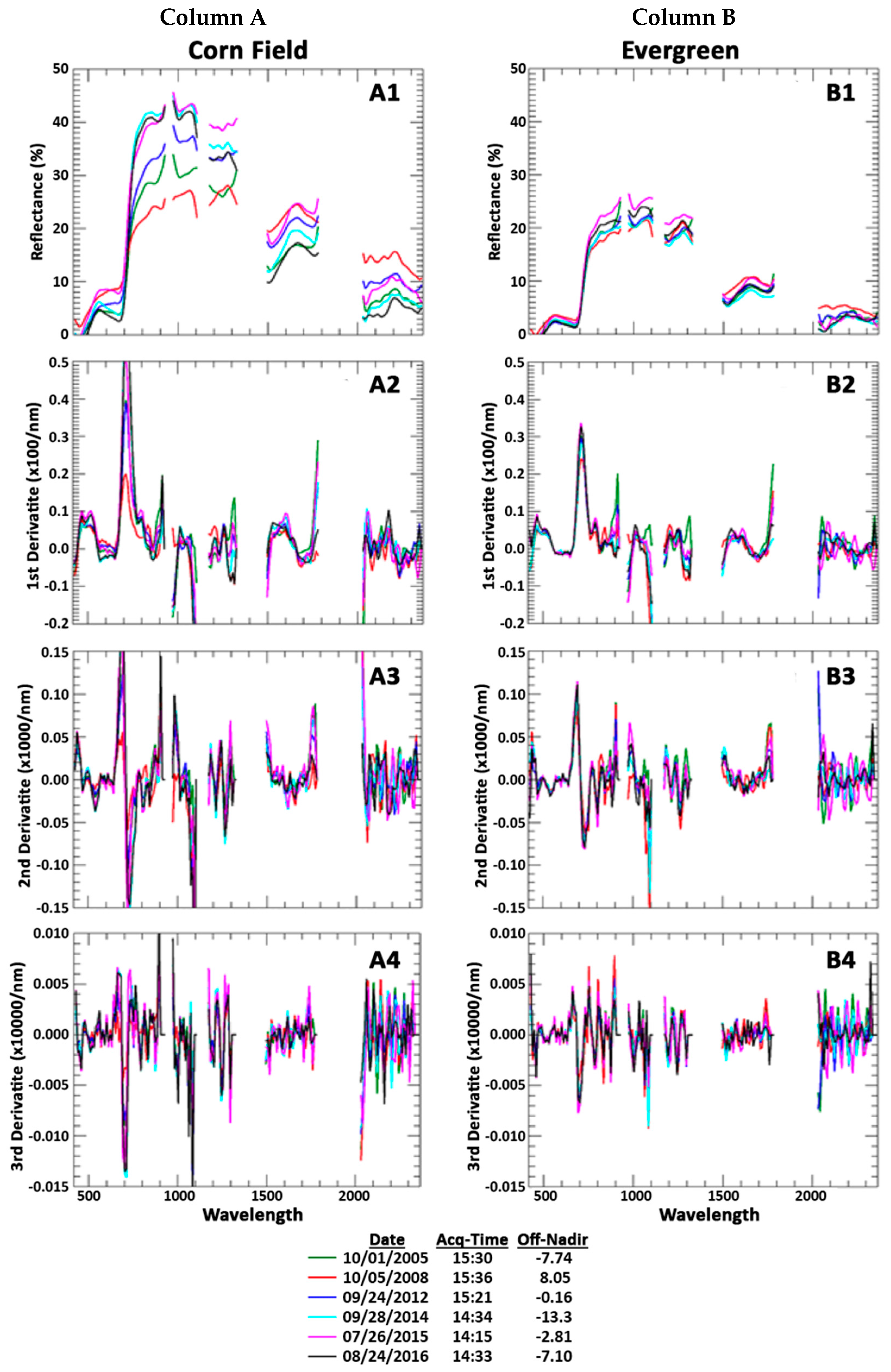
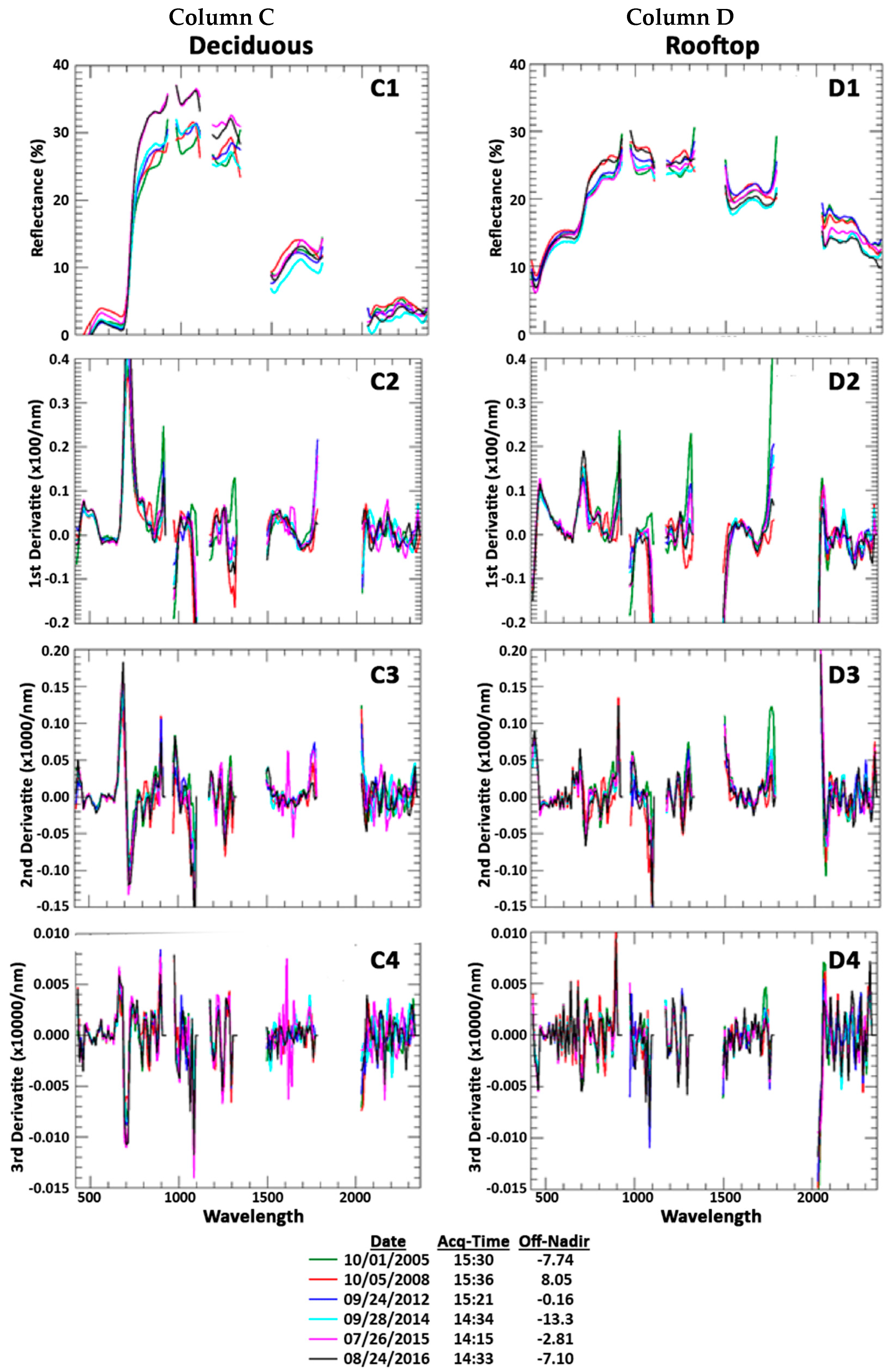
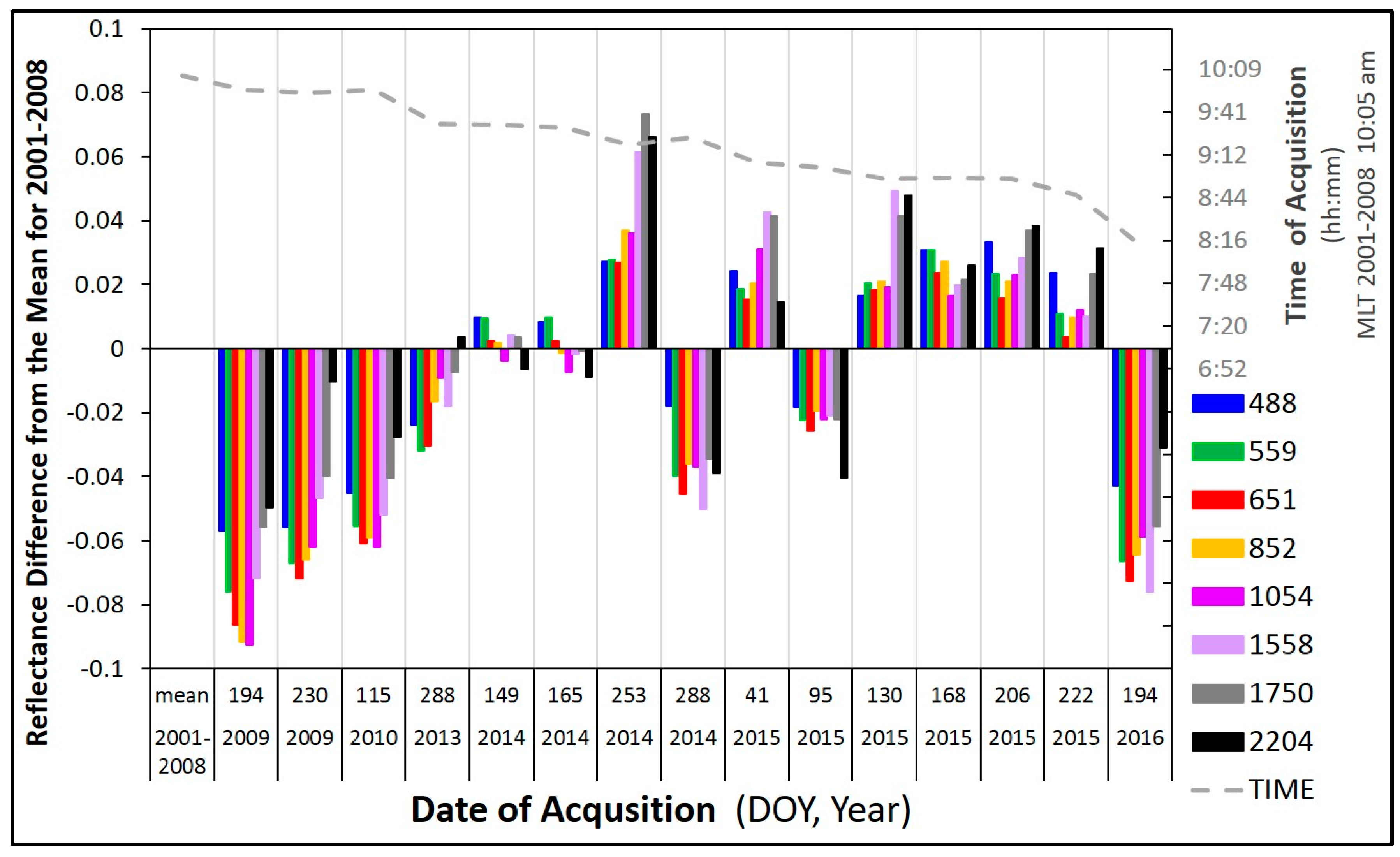

| Site Name | Central Coordinates (Longitude, Latitude) | Dominant Land Cover |
|---|---|---|
| Park Falls, Wisconsin | 90.18°W, 45.58°N | Mixed hardwood forest |
| Howland Forest, Maine | 68.5°W, 45.21°N | Mixed coniferous forest |
| BARC 1, Maryland | 76.85°W, 39.03°N | Evergreen, Corn Field |
| RRVP 2, Nevada PICS | 115.69°W, 38.5°N | Desert |
| Libya-4 PICS 3 | 24.40°E, 28.53°N | Desert |
| Landsat Date | ALI Date | Off Nadir |
|---|---|---|
| 8/17/2016 | 8/17/2016 | 20.10 |
| 8/15/2015 | 8/13/2015 | −0.30 |
| 8/12/2014 | 8/09/2014 | −5.70 |
| 9/26/2013 | 9/27/2013 | 6.10 |
| 8/06/2012 | 8/05/2012 | 4.50 |
| 8/20/2011 | 8/27/2011 | −2.72 |
| 8/17/2010 | 8/17/2010 | −2.50 |
| 9/23/2009 | 9/21/2009 | −1.00 |
| 9/12/2008 | 9/09/2008 | 5.60 |
| 6/30/2007 | 6/30/2007 | −7.20 |
| 8/11/2002 | 8/11/2002 | 3.50 |
| 5/04/2001 | 5/04/2001 | 0.13 |
| EO-1 ALI | Landsat 5 | Landsat 7 | |
|---|---|---|---|
| Wavelength (μm) | Wavelength (μm) | Wavelength (μm) | |
| Pan 1 | 0.48–0.69 | 0.52–0.90 | |
| Blue′ | 0.43–0.45 | ||
| Blue | 0.45–0.52 | 0.45–0.52 | 0.45–0.52 |
| Green | 0.53–0.61 | 0.52–0.60 | 0.52–0.60 |
| Red | 0.63–0.69 | 0.63–0.69 | 0.63–0.69 |
| NIR | 0.78–0.81 | 0.76–0.90 | 0.77–0.90 |
| NIR′ | 0.85–0.89 | ||
| SWIR′ | 1.20–1.30 | ||
| SWIR 1 | 1.55–1.75 | 1.55–1.75 | 1.55–1.75 |
| TIR | 10.40–12.50 | 10.40–12.50 | |
| SWIR 2 | 2.08–2.35 | 2.08–2.35 | 2.09–2.35 |
| Array | Bands | Wavelengths (nm) |
|---|---|---|
| VNIR | 8–57 (49) | 426–926 |
| SWIR1 | 7–120 (41) | 993–1346 |
| SWIR2 | 129–165 (36) | 1518–1800 |
| SWIR3 | 179–224 (5) | 1942–2395 |
| Total | (171) |
© 2017 by the authors. Licensee MDPI, Basel, Switzerland. This article is an open access article distributed under the terms and conditions of the Creative Commons Attribution (CC BY) license (http://creativecommons.org/licenses/by/4.0/).
Share and Cite
Franks, S.; Neigh, C.S.R.; Campbell, P.K.; Sun, G.; Yao, T.; Zhang, Q.; Huemmrich, K.F.; Middleton, E.M.; Ungar, S.G.; Frye, S.W. EO-1 Data Quality and Sensor Stability with Changing Orbital Precession at the End of a 16 Year Mission. Remote Sens. 2017, 9, 412. https://doi.org/10.3390/rs9050412
Franks S, Neigh CSR, Campbell PK, Sun G, Yao T, Zhang Q, Huemmrich KF, Middleton EM, Ungar SG, Frye SW. EO-1 Data Quality and Sensor Stability with Changing Orbital Precession at the End of a 16 Year Mission. Remote Sensing. 2017; 9(5):412. https://doi.org/10.3390/rs9050412
Chicago/Turabian StyleFranks, Shannon, Christopher S. R. Neigh, Petya K. Campbell, Guoqing Sun, Tian Yao, Qingyuan Zhang, Karl F. Huemmrich, Elizabeth M. Middleton, Stephen G. Ungar, and Stuart W. Frye. 2017. "EO-1 Data Quality and Sensor Stability with Changing Orbital Precession at the End of a 16 Year Mission" Remote Sensing 9, no. 5: 412. https://doi.org/10.3390/rs9050412






